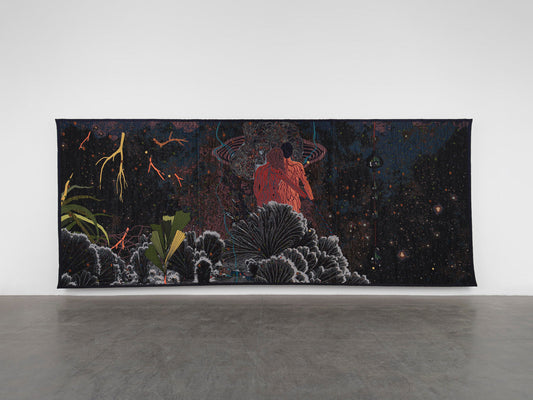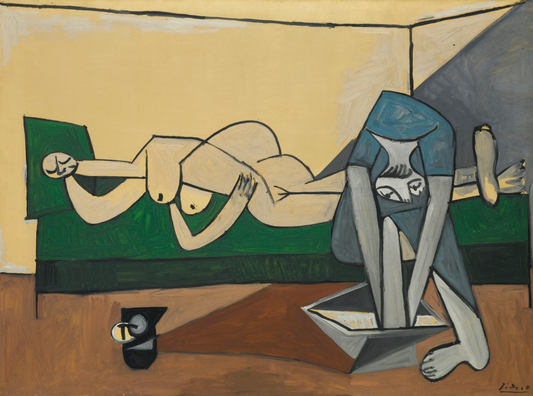Feature image: Jean-Baptiste-Siméon Chardin, A Bowl of Plums, c. 1740s via Phillips Collection
A Visual Guide to Paintings That Seem to Smell Good
Some paintings invite touch. Others stir emotion. A few go even further. These works carry scent. A bouquet of lilacs, a slice of pie, and a warm bath all can be evoked through paint alone. The impression of smell arises through the combination of color, texture, and subject matter. Artists throughout history have explored this idea, either consciously or instinctively. The following works possess a fragrance that transcends logic and resonates directly with the body. Here is a visual guide to paintings that appear to smell good.
Édouard Manet, Lilacs in the Sun (c. 1880)
This painting glows with soft outdoor light. The lilacs catch the sun, suggesting a fresh morning air and the earthy sweetness of new blooms. The scent is delicate, but full. Manet's brushwork allows petals to feel airy, almost weightless, which enhances the perception of a breeze brushing through the garden. The use of white and lavender creates a sensory softness, a visual inhale. This work captures a fleeting season and distills it into a fragrant memory, light on the skin and warming in the chest.

Henri Fantin-Latour, Roses in a Bowl (1885)
Fantin-Latour was a master of floral still lifes, and this canvas overflows with the smell of freshly cut roses. The blooms are painted at their fullest, heavy with age and scent, their petals just beginning to fold. The rich color of the flowers, deep pinks and reds set against a muted background, suggests intimacy and closeness. You almost lean in, as if to inhale. The glass bowl reflects soft light, enhancing the freshness of the arrangement. Fantin-Latour captures the interior hush of a quiet room filled with heady perfume.

Pierre Bonnard, The Bathroom (1932)
In Bonnard’s domestic interiors, color carries emotional and sensory weight. In this particular work, scent emerges from texture, light, and implied moisture. The warm palette suggests a late afternoon soak, while the light blue tiles and soft shadows convey comfort and routine. The figure, often thought to be his wife Marthe, is absorbed in the intimate act of bathing, and the scene becomes scented with lavender soap, steam, and human warmth. The overall atmosphere is gentle and enveloping, like the trace of perfume on a towel or the last warmth in bathwater.

Wayne Thiebaud, Pie Counter (1963)
This painting is not quiet. It smells loud and sweet. Thiebaud’s pies glisten with thick oil paint that mimics the shine of sugar glaze. The rows of desserts are inviting, and the suggestion of diner coffee, fresh pastry, and frosting fills the air. Each pie is a character, stacked in formation like a parade of scent and flavor. The viewer imagines buttery crusts, tart fruit, and syrupy fillings. Thiebaud does not only depict food; he captures the fantasy of it. The scent in this painting is as rich as the texture; it rises off the canvas like heat.

Rachel Ruysch, Still Life with Flowers on a Marble Tabletop (1716)
Ruysch’s botanical still-life painting is precise yet overflowing. Every flower is distinct in shape and species, and many of them are at different stages of bloom or decay. This multiplicity creates a layered scent, from fresh-cut stems to the deeper musk of fading petals. Ruysch includes small insects, a common symbol in Dutch painting, that hint at the biological pull of smell. The marble tabletop reflects the floral weight, grounding the bouquet and heightening the sensory overload. This painting holds the air of a sealed parlor filled with late-summer heat and overripe beauty.

Giorgio Morandi, Still Life (1956)
Morandi’s still lifes are restrained, but never dry. They carry the smell of sunlit interiors, of still air and quiet time. The bottles and vases are rendered in soft, dusty tones, ochres, greys, and creams, which suggest the muted scent of paper, stone, and long-closed cupboards. His brushwork flattens the objects slightly, allowing them to melt into one another, creating an atmosphere rather than a scene. This atmosphere feels dry but not sterile, like a room that has been lived in but rarely disturbed. The scent is faint but lasting, like something remembered.

John Singer Sargent, Madame X (1884)
Sargent’s portrait of Madame Gautreau carries a sharp, distinctive air. The smell here is not floral or clean. It is powdered, expensive, and intentional. The sheen of her black gown, the pale severity of her skin, and the posture of confident detachment all suggest a signature scent, something violet-based, powdered, with a touch of alcohol. This painting carries the smell of salons, of luxury, and of vanity. The composition is deliberate, emphasizing the gap between viewer and subject, but scent bridges that distance, entering through association.

Amy Sherald, An Ocean Away (2020)
In this contemporary portrait, scent comes not from lushness but from precision. Sherald’s figures are rendered in grayscale against vibrant color backgrounds. This contrast produces a feeling of freshness and clarity. The cool blue in this composition evokes ocean spray, citrus sunblock, and the smell of cotton after a day in the sun. The subject, poised and relaxed, holds that freshness without fragility. Sherald’s work offers a new kind of sensory atmosphere, one that feels modern, balanced, and unmistakably clean.

Claude Monet, Water Lilies and Japanese Bridge (1899)
Monet’s garden series is often described as meditative, but it is also olfactory. This painting, with its overlapping lily pads, soft water, and arching bridge, carries the scent of standing water, aquatic plants, and early summer air. The brushstrokes melt into each other, dissolving edges and creating a soft blur that mimics how scent fills space. It smells humid, quiet, and green. The layers of blue and green pigment feel like layers of smell, moss, pollen, damp stone, and light.

Kehinde Wiley, Portrait of Andries Stilte II (2006)
Wiley’s work is immersive. His use of vibrant patterning and floral motifs suggests fragrance as a form of power. This portrait smells bright and artificial, like a designer fragrance layered over fresh-cut stems. The background presses forward, crowding the figure with color and scent. The combination of Baroque form and contemporary style creates a dual sensation, spice and polish, flowers and synthetics. It is overwhelming in the best way. Wiley’s surface is sensory, decorative, and bold, like perfume worn with intent.

These paintings invite the viewer to imagine more than what they see. Through color choices, subject matter, and surface quality, the artists create a multi-sensory experience. Each work offers a different fragrance, some fresh, some sweet, some strange. Whether it is the imagined scent of a summer rose or the quiet smell of old vases in a still life, these paintings linger like perfume on the skin.
©ArtRKL® LLC 2021-2025. All rights reserved. This material may not be published, broadcast, rewritten or redistributed. ArtRKL® and its underscore design indicate trademarks of ArtRKL® LLC and its subsidiaries.
All archival images in this article are used under fair use for educational and non-commercial purposes. Proper credit has been given to photographers, archives, and original sources where known.





